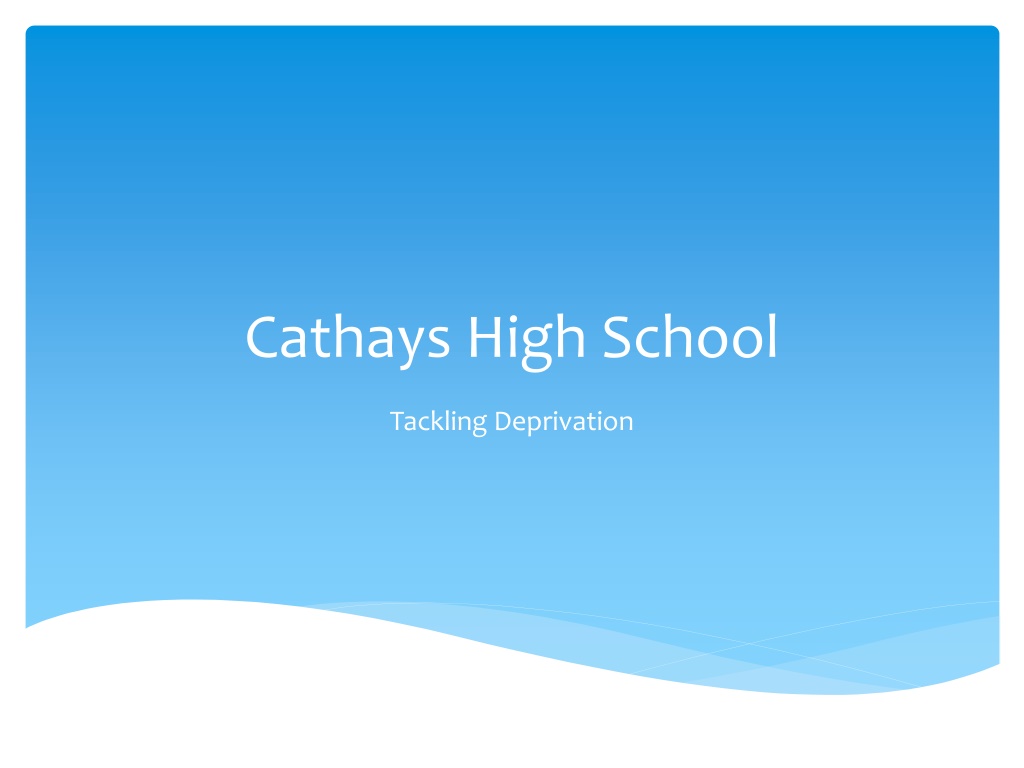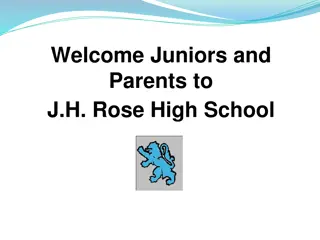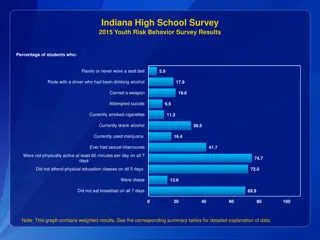Cathays High School
Dive into how Cathays High School is addressing deprivation within its community, highlighting innovative strategies and impactful initiatives aimed at improving outcomes for students facing challenges. Gain insight into their approach and the positive changes being made to support students in need.
Download Presentation

Please find below an Image/Link to download the presentation.
The content on the website is provided AS IS for your information and personal use only. It may not be sold, licensed, or shared on other websites without obtaining consent from the author.If you encounter any issues during the download, it is possible that the publisher has removed the file from their server.
You are allowed to download the files provided on this website for personal or commercial use, subject to the condition that they are used lawfully. All files are the property of their respective owners.
The content on the website is provided AS IS for your information and personal use only. It may not be sold, licensed, or shared on other websites without obtaining consent from the author.
E N D
Presentation Transcript
Cathays High School Tackling Deprivation
Context Cathays High School 11-19 English medium school near centre of Cardiff. NoR 886 (including 193 in 6thForm Entry Level 1 to Level 3 courses) 37% FSM 60% of pupils come from outside the catchment area of the school 69% EAL (43% below competent in English) 53 different ethnic groups and 64 languages other than English. 118 of the current years 7 to 11 came to Cathays High from outside UK (46 this year) Another 99 students (26 this year) started secondary education other UK schools, mostly in Cardiff (26% annual pupil turnover)
Challenges Significant numbers of pupils (around 30% in Years 7 to 11) enter the school below functional levels of literacy. Over 40% of pupils are identified with additional learning needs FSM pupils over-represented in these two groups. Significant increase in pupils from Czech and Slovak Roma backgrounds often are illiterate (-6 yrs 8mths) or functionally illiterate (below 9yrs 6mths) on arrival. 52% of pupils from Czech and Slovak Roma community are FSM. In 2010-11 attendance was 87.9% and there was significantly worse attendance amongst FSM pupils. Attendance of Czech and Slovak Roma Pupils in January 2012 was 69%.
Strategic Approach to Tackling deprivation AHT responsible for Inclusion and Wellbeing with explicit responsibility to develop strategies to tackle effects of poverty. Area Improvement Plans and Performance Management targets of TLR holders and other staff in Inclusion and Wellbeing Team reflect key priorities in tackling disadvantage Whole School Improvement Plan targets reflected Specific improvement plans written to target certain groups with acute deprivation e.g. Czech and Slovak Roma community Use of data to target groups from socio-economically deprived backgrounds in Inclusion and Wellbeing TLR holder meetings which focuses on a particular group e.g. White-British FSM Development of individual and group action plans for identified pupils in need of support.
Specific Action- Staff roles and responsibilities Re-structure of non-teaching pastoral support staff to become Inclusion and Wellbeing Officers 4 of the 7 go out to families as well as in-school work Faster action to address disaffection and poor attendance, behaviour and punctuality Strengthens link with parents as we often go to them 3 of the 7 more school based implementing strategies to keep pupils in school 2 are in charge of developing provision to avoid FTEs Head of School roles gave greater focus to positive engagement strategies HoY role has greater emphasis on tackling disadvantage and deprivation through use of data and leading on engagement strategies.
Specific Actions- Parental Engagement Every pupil in years 7, 10 and 11 is offered a family interview with a member of SMT Bilingual translation at Parents Evening Bring a Parent to School Day, Open Evening and New Parents Evening, Family Learning activities and Transition Saturdays- Year 7 Strategies to help parents, help their children s learning Meeting with Czech and Slovak Roma parents.
Specific Action- Using Community expertise Linking with Somali community support groups Inclusion and Wellbeing Officer from Czech and Slovak Roma community Developing links with local Mosques and engaging positive role models
Specific Actions- Developing Provision Development of KS3 Integrated Studies group focus on developing Literacy and Numeracy Development of KS4 Integrated Studies group developing literacy and numeracy and achieving Level 1 threshold Alternative Curriculum programme development
Specific Action- Current developments Development of Restorative Approaches Refining the data tracking system for ALN pupils Targeting FSM and other identified pupils vulnerable to disadvantage for enrichment opportunities in school and within the community.
Outcomes for Pupils FSM/Non-FSM Pupils KS3 The percentage of FSM pupils achieving the CSI was higher than the Family, local and national average figures for the five years between 2008-2012 and is higher than the national average in 2013, which is excellent. Gap between FSM and Non FSM at CSI L5+ is lower than the Family, Local and National averages According to FFT data, FSM pupils VA performance is significantly higher than expected over three years for the CSI and the average level, for all indicators in Maths and for L5+ in Science
Outcomes for Pupils (Contd) FSM/Non-FSM Pupils KS4-2013 FSM L2 inc. E and M 2013 increased on previous 2 years Higher than Family and local average and equal to national average. The gap to non-FSM performance was considerably smaller than Family, Local and National averages. FSM performance better than Family, Local and National averages at L1, CSI and Capped Points Score Increased over 3 years on these measures and the L2 threshold.
Outcomes (Contd) Whole school attendance increased: 87.9%-2010-11 90.5%- 2011-12 91.8%- 2012-13 93.2%- 2013- April- 2014 Attendance of Czech and Slovak Roma community increased: 69% Jan 2012 88% April 2014 FSM pupils attendance is over 92.5% Non- FSM attendance is currently 1% higher than FSM pupil attendance. Gap closed compared to 2012-13 where it was almost 2%.























